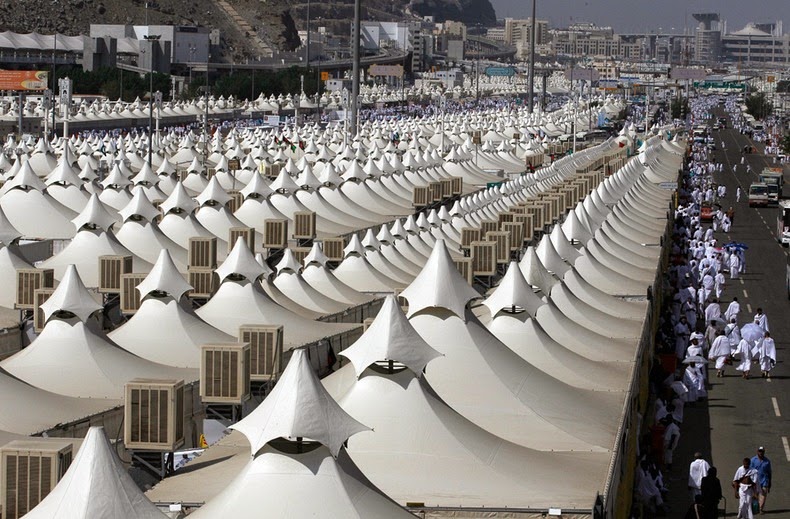Mina, The City of Tents
Mina is a small city located inside a low lying valley in the province
of Makkh, in western Saudi Arabia, about 8 km to the east of the Holy
city of Mecca. Inside the 20 square km valley, tents cover every open
space, as far as the eye can see, neatly arranged, row after row. It is
in these tents Hajj pilgrims stay overnight during the five days of each
Haj season. For the rest of the year, Mina remains pretty much
deserted.
There are more than 100,000 air-conditioned tents in Mina providing temporary accommodation to 3 million pilgrims. The tents measure 8 meters by 8 meters and are constructed of fiberglass coated with Teflon in order to ensure high resistance to fire. Originally pilgrims brought their own tents which they would erect in the flat plains of Mina. After Hajj is over, the tents would be dismantled, everything packed and taken back. Then sometime in the 1990s, the Saudi government installed permanent cotton tents relieving pilgrims of the burden of having to carry their own camping equipment. But after a massive fire that swept through the tent city killing nearly 350 pilgrims in 1997, the current permanent fire-proof city was built.

Photo credit
The tents are segregated into several camps, each of which possesses its own exterior wall, and is connected to other camps by pathways. Each camp is equipped with a kitchen, bathrooms, and ablution facilities. Every tent is color-coded by country and numbered, and all the haajis are supposed to have badges with their color and number on it, in case they get lost.
In the last two years, the city underwent a massive change with the government investing billions of riyals into many infrastructural projects to ease the daunting and physically demanding rituals of the annual pilgrimage. A comprehensive fire safety network consisting of heat-sensitive water sprinkler are linked to an alarm system was implemented to prevent repeat the tragedy of 1997.

Photo credit

Photo credit

Photo credit

Photo credit

Photo credit

Photo credit

Photo credit

Photo credit

Photo credit

Photo credit
Source: Wikipedia / Arabnews / Sunni Forum
There are more than 100,000 air-conditioned tents in Mina providing temporary accommodation to 3 million pilgrims. The tents measure 8 meters by 8 meters and are constructed of fiberglass coated with Teflon in order to ensure high resistance to fire. Originally pilgrims brought their own tents which they would erect in the flat plains of Mina. After Hajj is over, the tents would be dismantled, everything packed and taken back. Then sometime in the 1990s, the Saudi government installed permanent cotton tents relieving pilgrims of the burden of having to carry their own camping equipment. But after a massive fire that swept through the tent city killing nearly 350 pilgrims in 1997, the current permanent fire-proof city was built.

Photo credit
The tents are segregated into several camps, each of which possesses its own exterior wall, and is connected to other camps by pathways. Each camp is equipped with a kitchen, bathrooms, and ablution facilities. Every tent is color-coded by country and numbered, and all the haajis are supposed to have badges with their color and number on it, in case they get lost.
In the last two years, the city underwent a massive change with the government investing billions of riyals into many infrastructural projects to ease the daunting and physically demanding rituals of the annual pilgrimage. A comprehensive fire safety network consisting of heat-sensitive water sprinkler are linked to an alarm system was implemented to prevent repeat the tragedy of 1997.

Photo credit

Photo credit

Photo credit

Photo credit

Photo credit

Photo credit

Photo credit

Photo credit

Photo credit

Photo credit
Source: Wikipedia / Arabnews / Sunni Forum